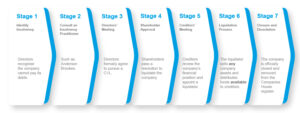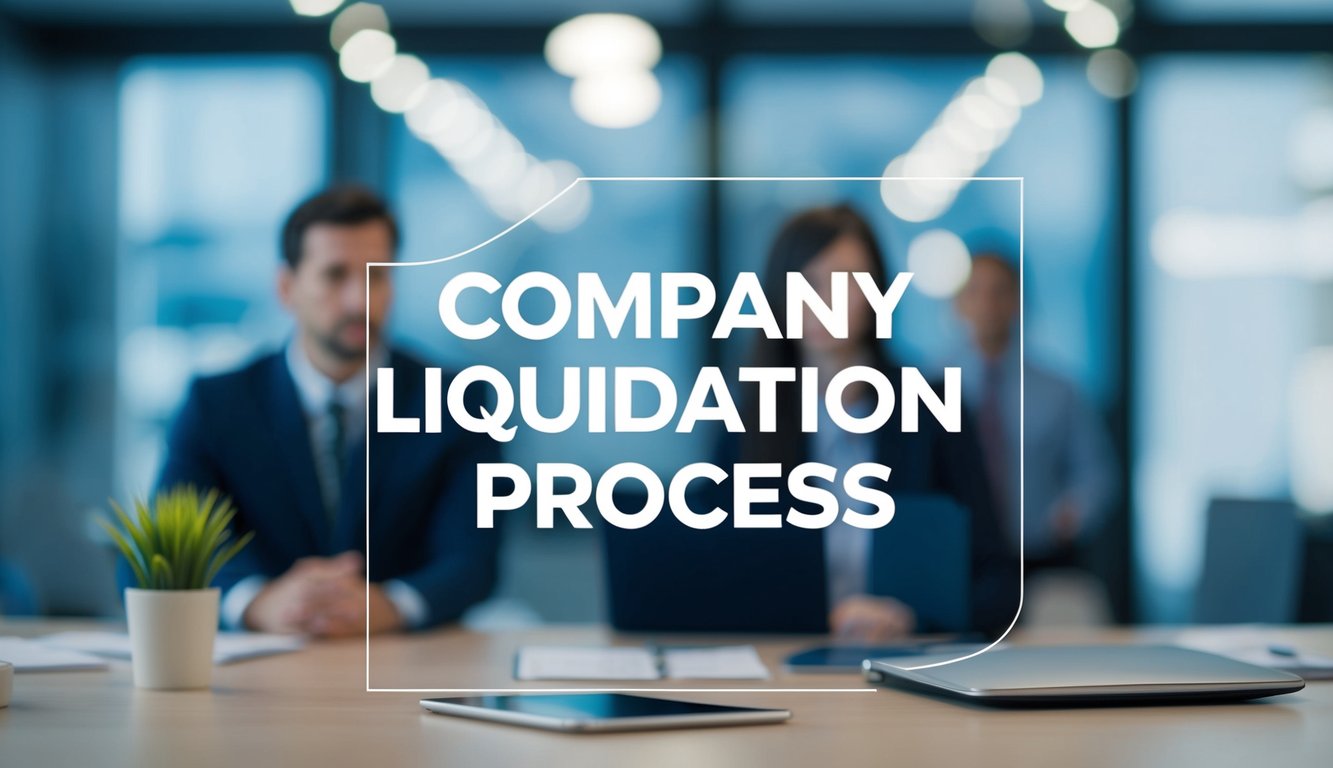Company Liquidation Process: A Step-by-Step Guide to Closing Your Business
Understanding Company Liquidation
When your company enters liquidation, it ceases trading and all assets are sold to pay creditors. The process formally dissolves your business and removes it from the Companies House register.
A licensed insolvency practitioner, such as Anderson Brookes, manages the entire procedure, taking control of company affairs and investigating previous trading activities.
Your company’s assets will be valued and sold at the best possible price. The funds are distributed to creditors according to a strict priority order established by UK law.
Types of Liquidation
- Creditors’ Voluntary Liquidation (CVL): You and your shareholders choose to close an insolvent company
- Members’ Voluntary Liquidation (MVL): Shareholders initiate closure of a solvent company
- Forced closure through court order
- Usually initiated by creditors owed £750 or more
- The Official Receiver takes initial control
Each type follows different procedures and timelines. Your choice depends on your company’s financial position and whether creditors are pursuing legal action.
The implications vary significantly between voluntary and compulsory routes, affecting your future business activities and director responsibilities.
Free Consultation – advice@andersonbrookes.co.uk or call on 0800 1804 935 our freephone number (including from mobiles).
Google Reviews

Legal Framework for Liquidation
Company liquidation operates within a structured legal system that defines the processes, responsibilities, and requirements for winding up a business. The framework ensures proper distribution of assets and protection of creditor interests.
Applicable Legislation
The Companies Act serves as the primary legislation governing corporate liquidation in the UK. Your company must follow the provisions set forth in the Royal Legislative Decree, which establishes the fundamental rules for dissolution. This legislation outlines specific procedures for different types of liquidation – voluntary and compulsory.
Roles and Responsibilities of the Liquidator
Your appointed liquidator must act as an independent officer with specific legal duties. They take control of company assets and manage the entire liquidation process.
The liquidator’s key responsibilities include:
- Collecting and selling company assets
- Investigating company affairs and director conduct
- Distributing proceeds to creditors in order of priority
- Maintaining accurate records of all transactions
The liquidator must report to creditors regularly and ensure fair treatment of all parties involved. Your company directors must cooperate fully by providing necessary documentation and information throughout the process.
Professional qualifications and licensing are required for liquidators to practice. They must maintain independence and avoid conflicts of interest while performing their duties. Rikki Burton is one of our licensed IPs here at Anderson Brookes.
Initiating the Liquidation Process
The liquidation process requires careful preparation and proper legal documentation to dissolve your company effectively. Your company must meet specific criteria to qualify for liquidation. The most common ground is insolvency, where your company cannot pay its debts when they become due. You must have clear evidence that your company’s liabilities exceed its assets or that it fails the cash flow test. Directors must demonstrate they have explored all other viable options before proceeding with liquidation. We have worked with thousands of Directors – so encourage you to contact us to discuss the specifics of your case.
Filing for Liquidation
You need to appoint a licensed insolvency practitioner to handle the liquidation process. The practitioner will guide you through the necessary documentation.
Your first step is to hold a board meeting where directors vote on the winding-up resolution. You must notify shareholders and arrange a general meeting within 14 days.
Key documents for filing include:
- Declaration of Solvency (for voluntary liquidation)
- Statement of Affairs
- Notice to creditors
- Appointment of liquidator forms
All paperwork must be submitted to Companies House and the Insolvency Service within strict timeframes.
Liquidation Process – 7 Stages

Anderson Brookes can place a business into liquidation within 8 days! Contact us today.
Free Consultation – advice@andersonbrookes.co.uk or call on 0800 1804 935 our freephone number (including from mobiles).
Roles of Key Stakeholders
When a company enters liquidation – there are several key stakeholders including the company directors, creditors and shareholders, as well as the liquidator.
Duties of Company Directors
Directors must cooperate fully with the appointed liquidator and provide complete access to company records, assets and financial information. Your primary duties include preparing a statement of affairs detailing the company’s assets, liabilities and creditor information.
You have a legal obligation to cease trading immediately upon entering liquidation unless specifically authorised by the liquidator. Directors who continue unauthorised trading risk personal liability.
You must attend meetings with the liquidator when requested and assist in identifying and securing company assets. Failure to fulfil these duties can result in director disqualification for up to 15 years.
Rights of Creditors
Secured creditors maintain their right to claim against specific assets used as collateral. Your position in the creditor hierarchy determines payment priority.
You can form a creditors’ committee to represent collective interests during the liquidation process. This committee has the power to approve liquidator fees and challenge decisions.
Creditors must submit proof of debt forms to stake their claim. You have the right to attend creditors’ meetings and vote on important decisions affecting asset distribution.
Interest of Shareholders
Your rights as a shareholder become severely limited once liquidation begins. You can only receive distributions after all creditors have been paid in full.
You maintain the right to attend shareholder meetings and receive updates about the liquidation progress. The liquidator must provide regular progress reports on asset realisation and distributions.
Shareholders may need to surrender share certificates and other company documents when requested by the liquidator. Your liability remains limited to any unpaid amount on shares unless wrongful trading is proven.

The Liquidation Procedure
A liquidation procedure follows specific legal steps that vary based on whether it’s compulsory or voluntary. The process requires careful attention to detail and proper documentation at each stage.
Steps in Compulsory Liquidation
A court order initiates compulsory liquidation after creditors petition for your company’s winding up. The court appoints an official receiver to take control of your company’s affairs.
The official receiver freezes company bank accounts and halts all business operations immediately. They will contact you to arrange an interview and request detailed company records.
Your company assets undergo professional valuation before being sold. The liquidator distributes proceeds to creditors according to their priority ranking.
Steps in Voluntary Liquidation
You must hold a board meeting to propose voluntary liquidation and obtain a Declaration of Solvency if your company is solvent. Directors need to arrange a shareholders’ meeting to pass special resolutions for liquidation.
An appointed insolvency practitioner takes control of the company’s affairs and notifies Companies House within 14 days.
The liquidator sells company assets, settles outstanding debts, and distributes remaining funds to shareholders. They handle all necessary paperwork and tax requirements.
Once all matters are settled, the liquidator files final accounts with Companies House. Your company is officially dissolved three months after these documents are registered.
Free Consultation – advice@andersonbrookes.co.uk or call on 0800 1804 935 our freephone number (including from mobiles).
Asset Realisation and Distribution
The liquidator must systematically convert company assets into cash and distribute the proceeds according to strict legal priorities. Fixed charge holders receive payment first, followed by liquidation costs and preferential creditors, before any remaining funds go to unsecured creditors.
Gathering and Valuing Assets
A licensed insolvency practitioner conducts a thorough asset audit immediately upon appointment. This includes physical assets, intellectual property, outstanding invoices, and any legal claims.
Professional valuers assess each significant asset to determine fair market value. The goal is to achieve the best possible price within reasonable timeframes.
You’ll find the liquidator maintains detailed records of all identified assets, including:
- Plant and machinery
- Property and land
- Stock and inventory
- Vehicles and equipment
- Intellectual property rights
- Book debts and accounts receivable
Settling Claims
The liquidator reviews all creditor claims against strict legal criteria. Fixed charge holders have first claim on their secured assets.
Liquidation expenses and costs must be paid from available free assets. These include the liquidator’s fees, legal costs, and expenses incurred during asset realisation.
Preferential creditors, including employees owed wages and holiday pay, receive priority over unsecured creditors. The law sets specific limits on preferential claims.
A prescribed portion of net property must be set aside for unsecured creditors when floating charges exist from 15 September 2003 onwards.
Distribution of Proceeds
You must follow the strict order of payment priority:
- Fixed charge holders
- Liquidation costs and expenses
- Preferential creditors
- Floating charge holders
- Unsecured creditors
- Shareholders (if surplus remains)
The liquidator can make interim distributions when sufficient funds are available. Each creditor receives a percentage based on their verified claim amount.
Clear communication keeps creditors informed of progress through regular updates and formal reports.
Dealing with Preferential and Secured Creditors
The liquidation process follows a strict order of payment priority established by the Insolvency Act 1986, which determines how creditors receive their funds during company dissolution. Fixed charge holders and preferential creditors take precedence in debt repayment.
Priority of Claims
The liquidator must pay the insolvency practitioner’s fees before distributing any remaining assets. Fixed charge holders secure the highest priority, receiving payment from the sale of specific assets they hold security over.
Preferential creditors rank next in the payment hierarchy. These include employees owed wages and holiday pay, along with certain pension contributions.
Floating charge holders follow, securing payment from the company’s fluctuating assets like stock and equipment.
Personal injury claimants and environmental claims maintain preferential status, ensuring protection for affected parties.
Secured vs Unsecured Creditors
Secured creditors hold specific rights over company assets through fixed or floating charges. Fixed charges typically cover property or equipment, whilst floating charges apply to changeable assets.
Your position as a secured creditor offers greater protection during liquidation. You can claim against the secured assets directly, often leading to higher recovery rates.
Unsecured creditors, such as suppliers and utility companies, receive payment only after secured and preferential creditors. Their recovery rates tend to be significantly lower.
If you hold a personal guarantee, you can pursue both the company assets and the guarantor for repayment.

Challenges in Liquidation
Your company’s asset structure can significantly impact the liquidation timeline and success. Intellectual property rights, specialised equipment, and unique inventory items often prove challenging to value accurately.
Tangible assets like machinery might require specialist appraisers to determine fair market value. This process becomes more complex when dealing with seasonal inventory or perishable goods.
Digital assets present their own complications. Your company’s software licenses, customer databases, and proprietary technology need careful handling to preserve value during the liquidation process.
International Considerations
Operating across borders introduces multiple layers of complexity to your liquidation process. Different jurisdictions have varying insolvency laws and regulatory requirements.
Your assets located in foreign countries may be subject to local creditor claims and asset-freezing orders. This can create conflicts between different legal systems.
Currency fluctuations can affect the value of your international assets during the liquidation period. You’ll need to consider exchange rate risks when planning asset sales.
Tax implications vary by country, and you must comply with multiple tax authorities’ requirements. This often necessitates engaging local experts in each jurisdiction where your company holds assets.
Free Consultation – advice@andersonbrookes.co.uk or call on 0800 1804 935 our freephone number (including from mobiles).
Finalising the Liquidation Process
The final stages of company liquidation involve concluding all financial matters and legally dissolving the business entity through Companies House.
Closure of Company Affairs
The liquidator must sell all remaining company assets and distribute the proceeds to creditors according to their priority ranking. You’ll receive a detailed report showing how the funds were allocated.
Any surplus funds after paying creditors will be distributed to shareholders based on their ownership percentages.
The liquidator will settle outstanding tax matters with HMRC and ensure all necessary tax returns are filed.
All company bank accounts must be closed, and any remaining contracts or agreements must be terminated properly.
Dissolution of the Company
The liquidator submits final accounts to Companies House along with a notice that the liquidation is complete.
You must keep all company records for at least six years after the dissolution date. These include financial statements, meeting minutes and important correspondence.
Companies House will publish a notice in The Gazette announcing their intention to strike the company off the register.
After two months, if no objections are received, the company is officially dissolved and ceases to exist as a legal entity.
All business names and trademarks associated with the company become available for others to use once dissolution is complete.
Post-Liquidation Considerations
Proper handling of employee terminations and maintaining required business records are key responsibilities that remain after your company closes through liquidation.
Employee Redundancies
You must follow strict legal requirements when making staff redundant during liquidation. Notify employees in writing about their redundancy and provide clear information about their final pay, including outstanding wages, holiday pay, and any statutory redundancy payments they’re entitled to.
The liquidator will help calculate redundancy payments based on factors like length of service and age. Employees can claim unpaid wages and redundancy pay from the National Insurance Fund if the company lacks sufficient assets.
Staff should receive form P45s and written confirmation of their employment dates for future reference.
Records Retention
You must keep specific company records for set periods after liquidation. Retain all financial documents, including accounts, bank statements and tax records for 6 years minimum.
Store employment records like contracts, payroll data and personnel files for at least 6 years. The liquidator needs copies of key documents to complete their duties.
Maintain records of director decisions, board minutes and shareholder resolutions. Store everything securely but accessibly in case of future enquiries from HMRC or the liquidator.
Consider digitising paper records while ensuring proper backup systems are in place.
You may also like:

Frequently Asked Questions
What are the implications for directors when a company enters liquidation?
Directors lose control over company operations and assets once liquidation begins. Your powers cease immediately when the liquidator takes control.
Your conduct during the time leading up to liquidation will be investigated. If found guilty of wrongful trading or other misconduct, you could face personal liability for company debts.
Credit ratings often suffer, and you may face restrictions on directing other companies.
Could you outline the steps involved in the company liquidation process?
You must first appoint a licensed insolvency practitioner to assess your company’s financial position. The practitioner will review all documentation and assets.
A creditors’ meeting is arranged to approve the liquidation. The company’s bank accounts are frozen, and trading ceases.
The liquidator sells assets and distributes proceeds to creditors according to legal priority.
What are the common grounds for a company to be liquidated?
Inability to pay debts when they fall due is the primary reason. This includes failing to pay creditors within statutory demand periods.
Mounting tax liabilities and continuous trading losses often trigger liquidation.
Court orders following disputes or regulatory breaches can force liquidation.
What is the most cost-effective method to liquidate a company?
Creditors’ Voluntary Liquidation (CVL) typically costs less than court-ordered liquidation. Fees usually range from £4,000 to £10,000, depending on complexity.
Early action reduces costs by preventing debt accumulation. Working cooperatively with the insolvency practitioner helps minimise expenses.
What consequences do employees face if a company undergoes liquidation?
Your employment contract terminates immediately. You become a preferential creditor for unpaid wages and holiday pay.
The government’s Redundancy Payments Service can cover certain entitlements up to statutory limits.
You may claim redundancy pay, arrears of wages, and holiday pay through the National Insurance Fund.
How does creditor’s voluntary liquidation differ from member’s voluntary liquidation?
Creditors’ Voluntary Liquidation occurs when the company is insolvent and cannot pay its debts. Directors initiate this process with creditor approval.
Members’ Voluntary Liquidation applies to solvent companies. Shareholders choose to wind up the business and distribute assets.
The key distinction lies in solvency status and who controls the process.

